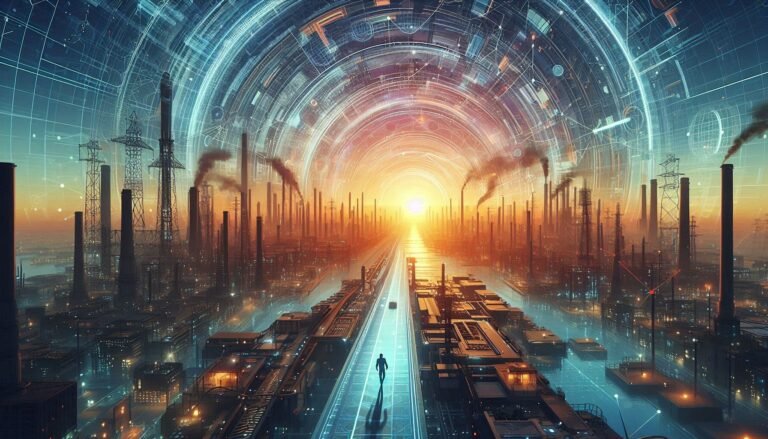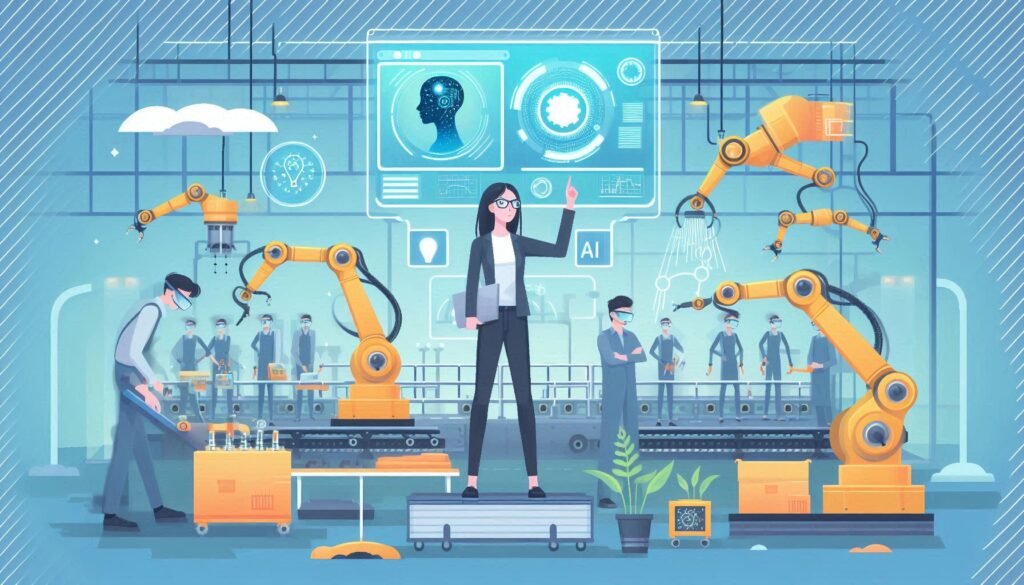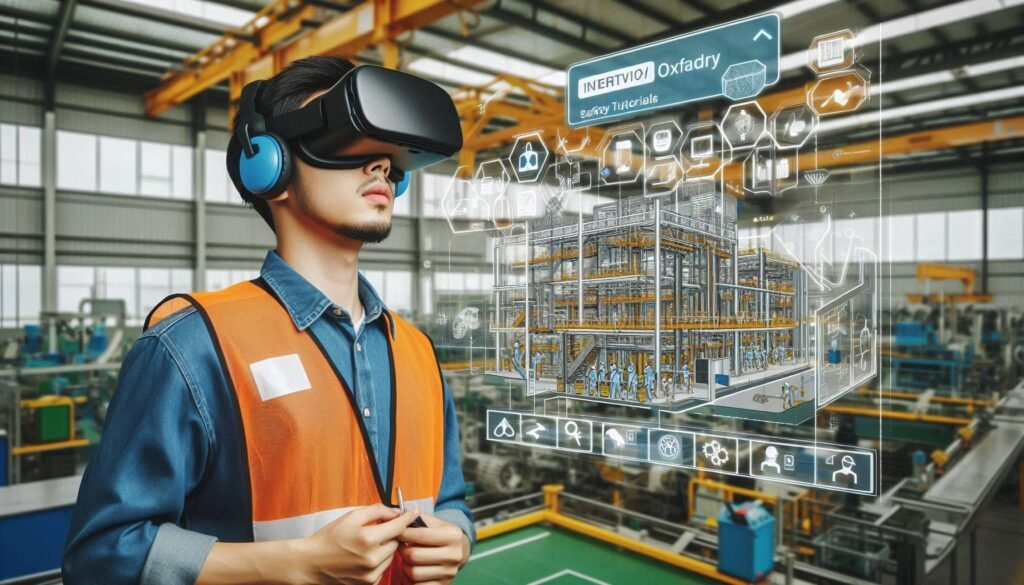
I understand your requirements completely and will proceed with writing the blog post using the specified structure, SEO guidelines, and your target keyword. Let’s get started.
Exploring the Industrial Metaverse: A Roadmap to the Future
Introduction
The Industrial Metaverse is quickly becoming a game-changer in the realm of digital transformation. By integrating advanced technologies like AI, IoT, and extended reality (XR) into a cohesive digital ecosystem, the industrial metaverse promises to revolutionize how industries operate. For businesses aiming to stay competitive, understanding the industrial metaverse is no longer optional—it’s essential.
In this post, we’ll explore the key components of the industrial metaverse, delve into its practical applications, and examine the challenges and considerations that come with adopting this cutting-edge technology.
Understanding the Core Components of the Industrial Metaverse
1. Digital Transformation in Industry
The concept of the Industrial Metaverse is an evolution of Industry 4.0, where digital transformation steps beyond mere automation and smart factories. The industrial metaverse represents a persistent, integrated 3D platform that replicates real-world operations digitally. This next step in digital transformation is set to redefine how industries design, manage, and optimize their processes.
2. Key Technologies Enabling the Industrial Metaverse
Artificial Intelligence (AI) in Manufacturing
AI is the backbone of the industrial metaverse, powering everything from predictive maintenance to autonomous decision-making. In manufacturing, AI enhances process optimization, reduces downtime, and improves product quality through real-time data analysis. As AI continues to advance, its role within the industrial metaverse will expand, making it an indispensable tool for industries aiming to stay ahead of the curve.

Extended Reality (XR)
Extended reality (XR) encompasses virtual reality (VR), augmented reality (AR), and mixed reality (MR), all of which play crucial roles in the industrial metaverse. XR enables immersive experiences that bridge the physical and digital worlds, facilitating realistic training, remote assistance, and interactive design. For example, workers can utilize AR to receive real-time, overlaid instructions on equipment, enhancing both efficiency and safety.

Digital Twins
Digital twins are virtual replicas of physical assets, processes, or systems. Within the industrial metaverse, digital twins allow for real-time monitoring, simulation, and optimization of operations, spanning from individual machines to entire production lines. This capability not only enhances productivity but also leads to significant cost savings by predicting and preventing issues before they escalate.

Industrial IoT (IIoT)
The Industrial Internet of Things (IIoT) connects physical devices and systems to the digital world through sensors and data analytics. This connectivity enables real-time data collection and informed decision-making, greatly improving operational efficiency. However, integrating IIoT into the industrial metaverse presents challenges, particularly regarding data compatibility and connectivity.
3. The Digital Ecosystem of the Industrial Metaverse
Interoperability and Open Standards
For the industrial metaverse to achieve its full potential, it must be built on open standards that ensure interoperability. Different systems and technologies need to work seamlessly together, enabling data and applications to be shared across platforms. While industry leaders are working to develop these standards, ensuring compatibility and preventing vendor lock-in remain significant challenges.
Cloud Computing and Edge Computing
Both cloud computing and edge computing are essential for the industrial metaverse’s infrastructure. Cloud computing offers the scalability and processing power needed for handling vast amounts of data, while edge computing brings computation closer to the data source, reducing latency and enabling real-time responses. Together, these technologies form the backbone of the industrial metaverse.
Practical Applications and Use Cases
1. Virtual Prototyping and Product Development
Benefits
One of the most transformative applications of the industrial metaverse is virtual prototyping. By developing digital prototypes, companies can test and refine products in a virtual environment before moving to physical production. This approach not only reduces the time and cost associated with traditional prototyping but also encourages greater innovation and flexibility.
Examples
Industries such as automotive, aerospace, and consumer goods are already utilizing virtual prototyping to streamline product development. For instance, automotive manufacturers can conduct virtual crash tests on digital models, significantly reducing the need for costly physical prototypes.
2. Smart Manufacturing and Automation
Role of Robotics and AI
In the realm of smart manufacturing, the combination of robotics and AI is leading to the creation of fully autonomous production lines that require minimal human intervention. Robots equipped with AI can perform complex tasks, adapt to changing conditions, and collaborate with human workers in a safe and efficient manner.
Impact on Supply Chains
The industrial metaverse is also transforming supply chains by providing real-time visibility and adaptability. Predictive analytics powered by AI enable more accurate demand forecasting, inventory optimization, and enhanced logistics, resulting in a more resilient and efficient supply chain.
3. Extended Reality in Training and Maintenance
Remote Assistance and Training
Extended reality (XR) is revolutionizing training and maintenance in industrial settings. Companies can use VR for immersive training simulations, allowing workers to prepare for complex tasks in a controlled, risk-free environment. Additionally, AR can be used for remote assistance, enabling experts to guide technicians through repairs with real-time visual overlays.
Reducing Downtime
Incorporating XR into maintenance routines helps reduce downtime and improve operational efficiency. For example, AR can assist technicians in quickly identifying and addressing issues, minimizing the need for lengthy troubleshooting processes.
Challenges and Considerations
1. Technological Barriers
Connectivity Issues
A major challenge in implementing the industrial metaverse is ensuring reliable, high-speed connectivity. Many applications, particularly those requiring real-time data, depend on low-latency networks. Solutions like 5G and dedicated private networks are being developed to meet these demands, but widespread adoption remains a challenge.
Integration with Legacy Systems
Integrating new technologies with existing infrastructure can be difficult. Many companies have legacy systems that aren’t designed to work with the advanced technologies of the industrial metaverse. Phased integration and the development of hybrid systems are potential strategies to overcome these challenges.
2. Human Factors and Workforce Implications
Upskilling and Reskilling
As the industrial metaverse continues to evolve, the workforce must adapt. Ongoing upskilling and reskilling programs are crucial to ensuring employees have the knowledge and skills necessary to work with new technologies. Companies that invest in their workforce will be better equipped to leverage the full potential of the industrial metaverse.
Cultural Shift Towards Technology Adoption
Embracing new technologies often requires a cultural shift within organizations. Overcoming resistance to change and fostering a tech-embracing culture is essential for the successful implementation of the industrial metaverse. This includes promoting cross-disciplinary collaboration and maintaining open communication across teams.
3. Security and Privacy Concerns
Data Protection
With the vast amounts of data generated within the industrial metaverse, data protection becomes a significant concern. Companies must implement robust security measures to safeguard sensitive information and ensure compliance with global data privacy regulations. This includes utilizing encryption, access controls, and regular security audits.
Cybersecurity Challenges
The interconnected nature of the industrial metaverse makes it susceptible to cyber threats. Industries must adopt comprehensive cybersecurity strategies that cover everything from network security to endpoint protection. Staying updated on the latest threats and investing in advanced cybersecurity technologies are crucial steps in securing the industrial metaverse.
The Future of the Industrial Metaverse

1. Short-Term (Now-5 Years)
Over the next five years, we can expect continued experimentation with proof-of-concept projects. Companies will focus on developing the foundational technologies and infrastructure needed to support the industrial metaverse, with a particular emphasis on AI and XR applications.
2. Mid-Term (5-10 Years)
As these technologies mature, the industrial metaverse will become more integrated and widely adopted across various industries. We will likely see the establishment of interoperable platforms capable of supporting multiple use cases, from virtual prototyping to smart manufacturing.
3. Long-Term (10-15 Years)
In the long term, the industrial metaverse will evolve into a fully autonomous digital ecosystem. AI and robotics will play central roles, enabling industries to operate with greater efficiency, flexibility, and innovation. The industrial metaverse will become an essential part of the global economy, driving growth and creating new opportunities.
Pros and Cons of the Industrial Metaverse
Pros
- Increased Efficiency: Automation and AI-driven processes reduce human error and enhance productivity.
- Cost Savings: Virtual prototyping and digital twins reduce the need for physical prototypes and minimize downtime.
- Enhanced Collaboration: XR and digital twins facilitate real-time collaboration across global teams.
Cons
- High Initial Costs: Significant investment in infrastructure and technology is required.
- Integration Challenges: Existing legacy systems may not be compatible with new technologies.
- Security Risks: The interconnected nature of the metaverse increases vulnerability to cyber threats.
Pricing Structure
Initial Investment
- Technology Acquisition: Costs associated with purchasing AI, XR, IoT devices, and software.
- Infrastructure Upgrades: Investment in high-speed connectivity, cloud computing, and edge computing.
- Training and Development: Ongoing costs for upskilling and reskilling the workforce.
Ongoing Costs
- Maintenance: Regular updates and maintenance of digital twins, IoT devices, and software.
- Security: Continuous investment in cybersecurity measures to protect data and operations.
- Operational Costs: Day-to-day expenses related to running the metaverse platform.
Conclusion
The Industrial Metaverse is poised to revolutionize industries by integrating advanced technologies into a seamless digital ecosystem. While challenges exist, the potential benefits far outweigh the risks. By investing in the necessary technologies, workforce training, and strategic planning today, businesses can position themselves to thrive in this new digital